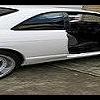Cryogenics
Announcements
-
Latest Posts
-
By Adam_ECR33 · Posted
Thank you, 100% the intent. New coils were due and the 17" sixers look/feel loads better than the stock wheels. The aero options are so spot on. Thanks for the warm welcome, all! -
98 r34 gtt Been rocking my latest setup and car running like never before. Have put a good 200 miles on it since all the latest changes and additions. everything is dialed in and have been driving it a bunch. However, all a sudden last weekend as soon as I pushed throttle passed 4k and the engine stumbles, (slow or fast acceleration) hesitates and doesn’t go above 4100 or so, like a misfire. Everything else seems fine. I had a “good” set of coil packs that I removed from car when I first got it when I changed them over to new coils. I swapped out current ones for those, but no change. I also changed the plugs, no change. Seems to rev over 4 when out of gear with no load just fine no “misfire”, but as soon as its in gear with a load of any kind, it “misfires” as soon as rpm drop back below 4 k it runs perfectly, smooth, starts, restarts and drives fine as long as I keep it below 4 k while in gear. All readings look fine, no CEL Any idea as to what could all a sudden cause an issue when pushing rpms passed 4 k?
-
When you say your cams are 272/262 is that 272in and 262ex?
-
We're arguing semantics. I am saying 45 accel and a 55 deccel ramp are "2 ways". Even a 45 degree ramp and an 89 degree ramp is "2 ways", because it is literally... two ways. The cusco 55/30 ramp is a 2 way. It's two ways. I get it though - in normal nomenclature a "2 way" would be 45/45 or 55/55 or 60/60 i.e the same locking in both directions. And something like 45/65 would be considered "1.5 way". I would then say if we're getting into the nitty gritty then every locking diff is a "2 way" diff and we should not speak in 1.5, or 2 ways but ramp angles instead. Which ofc if one of those ramp angles is 90deg, that side is not doing any locking. :p So Nismo don't obviously sell 3 things. The fact of the matter that they only sell two items really goes to show that there's a 2 way and a "1,5 way" which is really a 1 way. I believe the actual lockup for the 'adjustability' of the GT pro is really just setting preload for when the ramps actually start locking up. It's not changing how much 'wayness' there is. It is (somehow) horribly explained. People just buy whatever diff and go "locks up good bruh" and that's what ends up on socials forever.
-





Recommended Posts
Create an account or sign in to comment
You need to be a member in order to leave a comment
Create an account
Sign up for a new account in our community. It's easy!
Register a new accountSign in
Already have an account? Sign in here.
Sign In Now